After loading all the boxes of goods that couldn’t freeze into the backseats of our trucks we (consisting of Ryan, Eric, Fawn and I) departed North Pole and headed north to Bettles. We stopped at Hilltop truck stop north of Fox for a hearty breakfast and to top of the gas tanks and gas jugs (the one gas station between here and Bettles is closed in the winter).
We followed the Elliot Highway until it turned towards Manley Hot Springs and the Dalton Highway branched to the north. The first section of the Dalton Highway (also known as the Haul Road) was rough gravel but after 20 miles it turned into a decent paved highway.
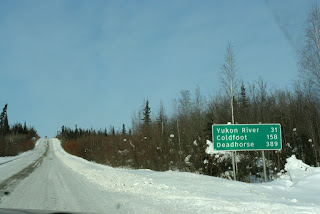 |
| Dalton Highway |
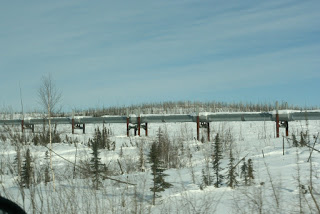 |
| The oil pipeline parallels the highway for most of the duration |
On the last ridge before the Yukon River the trees were caked in windblown snow. The ‘snow ghosts’ decreased as we descended down to the Yukon River Bridge. Two-and-a-half hours after breakfast at Hilltop truck stop we arrived at the rest area on the north side of the bridge.
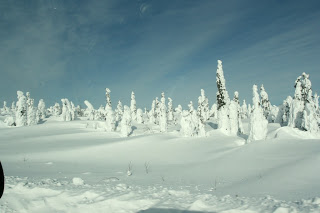 |
| Snow Ghosts |
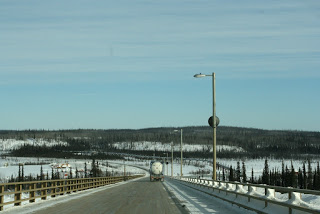 |
| Yukon River Bridge |
Near Finger Rock Mountain we encountered blowing snow which turned into small ground blizzards at points. One such place was Beaver Slide, an extremely steep hill that, thankfully, is straight. In addition to the blowing snow, the road was covered in a thin layer of ice, forcing us to slide down the Beaver Slide in an almost out-of-control state.
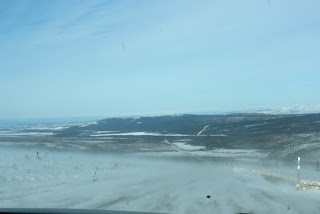 |
| Small ground blizzard going down Beaver Slide |
We stopped at the Arctic Circle rest area to take pictures of the sign and stretch our legs. After a total of 4.5 hours we reached the turn off for the Bettles winter road.
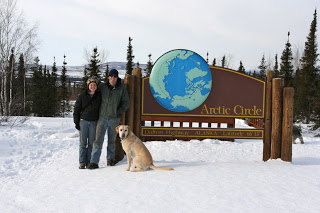 |
| On the Arctic Circle |
The Bettles winter road is only open for a month or two in late winter/early spring. A right-of-way is permanently cleared through the trees from the Haul Road to Bettles. Then late in the winter a dozer and grader clear the snow from the right-of-way, fill in the dips and creeks crossing, and leave huge snow berms on the sides. The frozen ground covered in packed snow makes a decent roadbed.
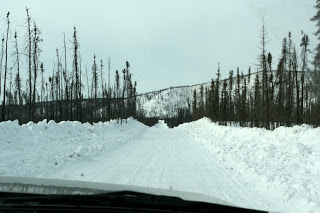 |
| Bettles Winter Road |
Right away we crossed the Jim River—my first river crossing in the truck. No bridges, just a plowed swath across the ice. Then there was a narrow, rough stretch where we hoped we wouldn’t meet any semi-trucks, if we did we would have to back-up quite a ways. The worst portion of the road came at Gordon’s Gulch—massive overflow. We started on the ice and started punching through. Then the road split and we had to decide to take the high or low route on the overflow. We opted for the high route even though it was sloped with a build-up of overflow since the low route looked steep. After chaining up both trucks, we crept forward while punching through the ice in spots—rough but no problem with chains.
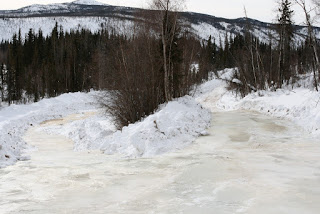 |
| Gordon’s Gulch full of overflow |
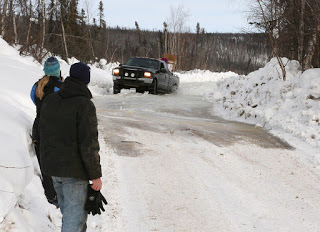 |
| Driving over the overflow and punching through |
The chains stayed on until the top of Jim River Hill and weren’t needed again. The notorious overflow at certain creeks was non-existent this year, making for a smooth ride (at 30 mph). The last major river we crossed was the South Fork of the Koyukuk which had a cardboard sign on the bank stating to not stop on the river—no problem.
As we neared Bettles, we encountered the burn from the 2004 fires. In spots, the fire burnt the trees on one side of the road and not on the other. The right-of-way acted as a fire break. We had good views of the Jack White Mountains from here on into Bettles. The extent of snow pack was evident from the beginning of the winter road but in some areas of the burn, I could barely see over the snow berm. The snow on the other side wasn’t much lower than the top of the berm in places—four to five feet deep!
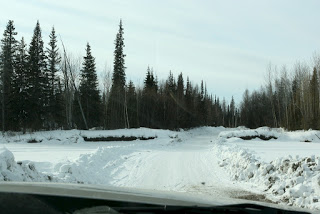 |
| Crossing the South Fork of the Koyukuk River |
Finally, I had been on the winter road to Bettles, just like most things in Bettles. The winter road is the main way to bring in building supplies, trucks, fuel, fuel tanks and goods to Bettles without paying air freight. Among the goods we brought in were a range for our house, insulation for the house floor, a shower pan, bikes, skis, potting soil and lots of food—six months worth of dried goods and frozen food. That included over 80 pounds of flour, over 60 pounds of meat, 25 pounds of sugar, 10 pounds of oatmeal, over 30 cans of fruit, 10 pounds of onions and five dozen eggs. On top of that was 170 pounds of dog food for Nelson. The work began as we pulled up to the little brown house surrounded by four feet of snow out to the road. A big thanks to Eric and Fawn for helping shovel a path and hauling in boxes.

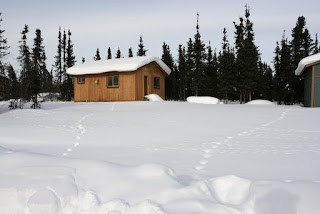
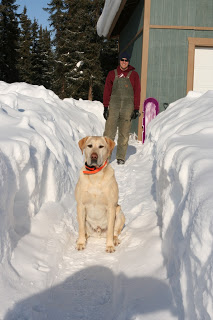
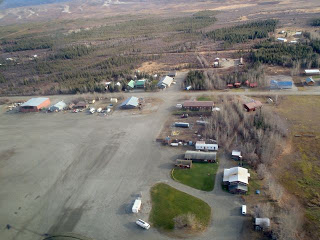
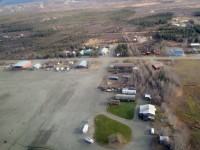
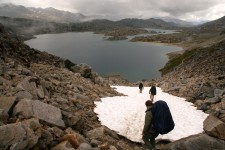

Is there more to this? I really enjoyed reading this. My cousin is working up in this area now. Thanks much
I’m glad you enjoyed it. I have more posts about Alaska under the “Life In Alaska” tab near the top of the page. Enjoy!